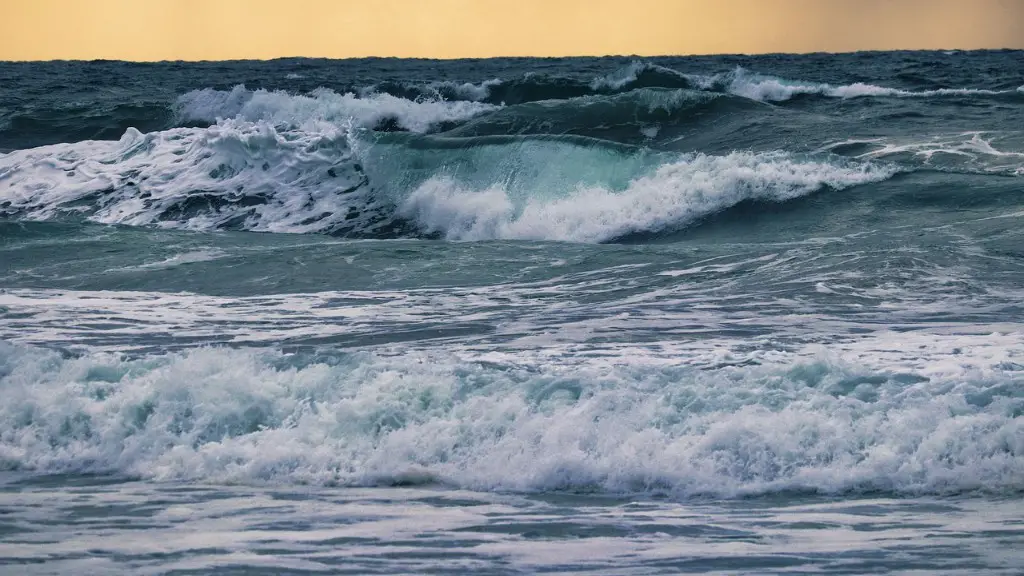Background Information
The South China Sea is located in the western Pacific Ocean and is an area of considerable geographic and economic significance. The waters contain around 11 billion barrels of oil and 190 trillion cubic feet of natural gas. In addition, it is a vital global trading hub with an estimated 30% of world’s maritime trade passing through the sea.
Since 1974, several countries with claims to the South China Sea have come into conflict. China, Taiwan and four ASEAN countries – Brunei, Vietnam, Malaysia, and the Philippines – have all sought to establish jurisdiction over parts of the sea. China and Taiwan claim a majority of the territory, as nine-dash line claims sovereignty over waters believed to be worth trillions of dollars. The dispute has become more complex as it draws in military interests.
The Territorial Claims
The nine-dash line covers the disputed areas of the South China Sea. The line was initially mapped out by the Republic of China in 1947 and was later taken over by the People’s Republic of China in 1949. It roughly follows the islands, reefs, and shoals surrounding the South China Sea, from the Gulf of Tonkin and Macclesfield Bank to the Strait of Taiwan in the north, and down around the Natuna Islands and James Shoal in the south. Each country vying for control of the South China Sea has its own interpretation of how the nine-dash line should be interpreted.
China claims the majority of the sea, including the Paracel and Spratly Islands. Its claim is based on its history in exercising control of the region. Taiwan also claims much of the sea, including Scarborough Shoal near the Philippines. Vietnam, a former imperial power in the area, claims the Paracel and Spratly Islands. While Brunei disputes China’s control of the area, Malaysia and the Philippines have official claims to reefs, atolls and other features in the South China Sea.
The Disputes Involvement of Economics and Security
The disputes over the South China Sea involve both economics and security. For example, many of the disputed areas contain highly sought after natural resources such as oil, gas and fish. The region is also a major shipping route, with some of the world’s busiest shipping lanes running through its contested waters.
On the security side, many of the countries involved in the dispute have ramped up military presence in the region. The majority of the nations involved have recently conducted large-scale military exercises and increased their naval vessels in an attempt to assert their sovereignty over the disputed waters. This has raised concerns about the potential for military conflicts in the South China Sea.
Experts’ Perspectives
Experts from both sides agree that the South China Sea dispute is a complex issue with no easy solution. Supporters of China’s claim are adamant that the region has historically been part of China’s territory. Those who favor the claims of the other nations argue that the nine-dash line is a vague marker of territory that does not fully account for the rights of the other nations.
The international community has made several attempts to resolve the dispute. The 2002 Declaration on the Conduct of Parties in the South China Sea is one of the most significant agreements, which calls on the parties to practice self-restraint and to refrain from activities that could increase tensions in the region. However, there have been no progress and the nine-dash line remains a point of contention.
Economic Implications
The conflict over the South China Sea has significant economic implications for all countries involved. Aside from the billions of dollars’ worth of natural resources in the region, there are fears of restricted access to shipping lanes. If the dispute results in a militarized conflict, there is the potential for major disruption to global trade, resulting in a loss of billions of dollars of economic activity and a significant loss of jobs.
Business owners and companies have begun to distance themselves from companies involved in South China Sea operations, as they increasingly become targets of boycotts. In addition, some companies have begun to take steps to ensure their operations in the region are compliant with international law.
International Law
As the dispute shows no sign of slowing down, many countries have begun to rely on international law to protect their economic interests in the South China Sea. International law sets out several principles for determining each country’s rights over the disputed areas. Under the United Nations Convention on the Law of the Sea (UNCLOS), countries are entitled to Exclusive Economic Zones (EEZs) of up to 200 nautical miles from their coasts. This means that the countries are entitled to their own natural resources within the EEZ, as well as permission to exploit, explore, and protect their marine environment.
The UNCLOS has been widely seen as instrumental in helping to settle the dispute over the South China Sea. However, it has also been criticized by China, as many of its claims are not explicitly recognized under the provisions of the convention.
China: Actions Speak Louder Than Words
Despite its claims to the South China Sea, China has taken steps to control the region. China has undertaken numerous construction projects in the area and placed military personnel on islands. It has also built structures such as airstrips, radar and communications equipment, and deep-water ports with associated artificial island developments.
These actions have drawn criticism from the international community, as many of the projects are seen as illegal under international law. China’s increased presence in the area has also been seen as a sign of aggression, and some countries are now looking to form coalitions to protect their interests in the disputed waters.
China’s Influence in the Region
China’s influence in the South China Sea is undeniable. It has the most powerful military presence in the region and is determined to assert its control. While some experts agree that China should be given some degree of control over the region, there are widespread concerns over its actions in the area. China’s actions have been seen as attempts to limit the rights of other countries in the region and its increasing militarization of the area has raised alarm bells.
International Responses
In response to China’s actions, several countries have taken steps to protect their interests in the South China Sea. The United States has maintained a military presence in the area, conducting “freedom of navigation” exercises to demonstrate that its allies’ economic and security rights in the area are protected. The US has also entered agreements with the Philippines, Japan, and Australia to operate military facilities in their territories to check China’s efforts to militarize the region.
In addition, other countries have taken steps to ensure that the rights of the other countries involved in the dispute are respected. France, India, and the United Kingdom have conducted naval exercises in the South China Sea in support of freedom of navigation and for greater compliance with international law.
China’s Response to International Pressure
In the face of international pressure, China has escalated its activities in the region and has repeatedly clashed with the US. China’s military has warned the US not to interfere in the South China Sea dispute, while threatening to take further action to protect its interests in the area.
In response to US and international pressure, China has recently proposed a new code of conduct for the disputed waters, in a bid to reduce tensions and to ensure that the rights of all parties are respected. However, there are still many doubts as to whether the proposed code of conduct is sufficient to curb China’s aggressive and militaristic behaviour.
Analysis and Insights
The situation in the South China Sea has been ongoing for the past few decades and shows no sign of slowing down. Despite the best efforts of the international community, tensions remain high and there is the potential for military conflicts in the disputed waters.
The dispute has significant economic and security implications for all countries involved and the international community has sought to bring an end to the conflict. Nevertheless, it appears that China is determined to maintain its hold on the region, despite international law and pressure from other countries. It is clear that actions, not words, will be needed in order to resolve this longstanding dispute.


